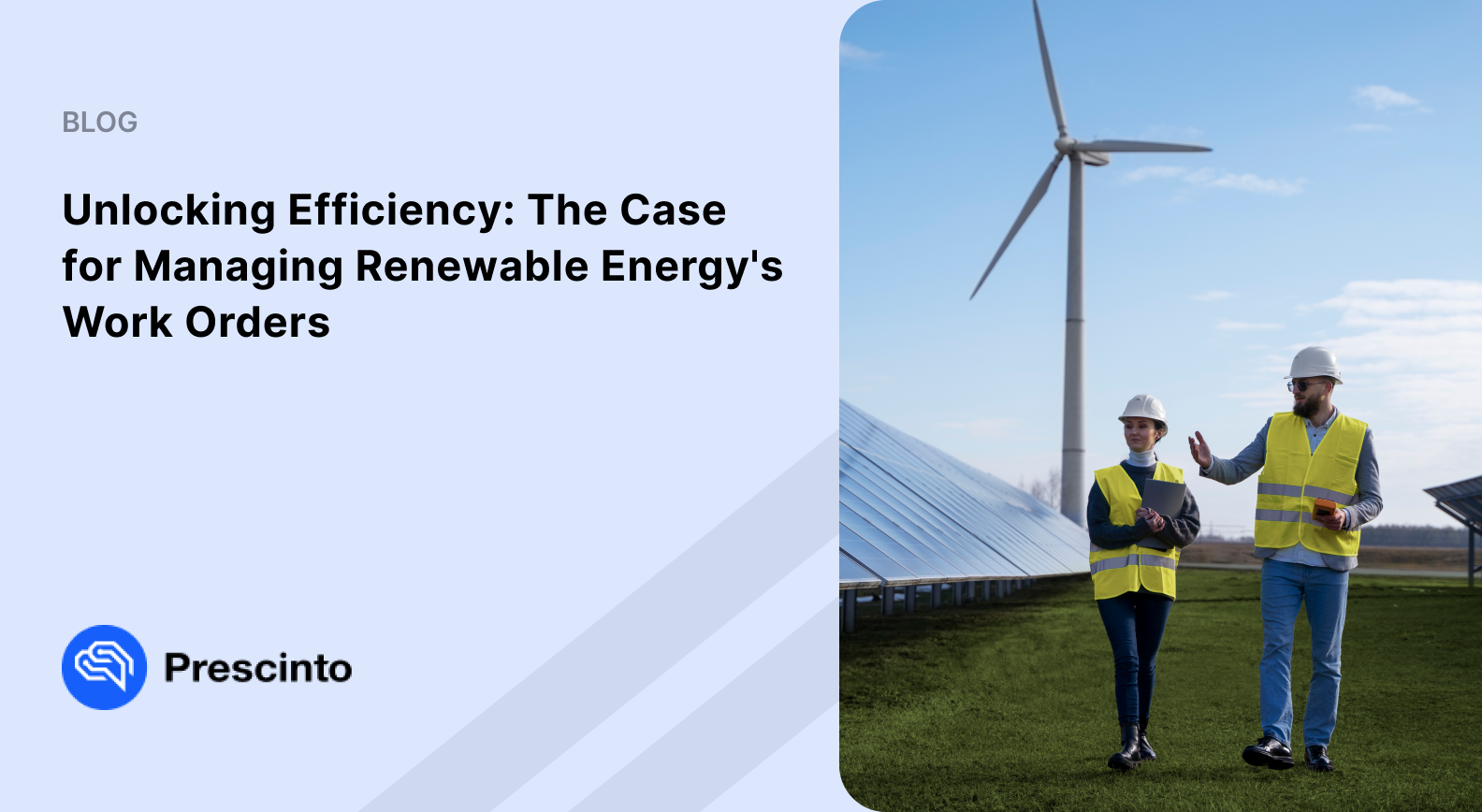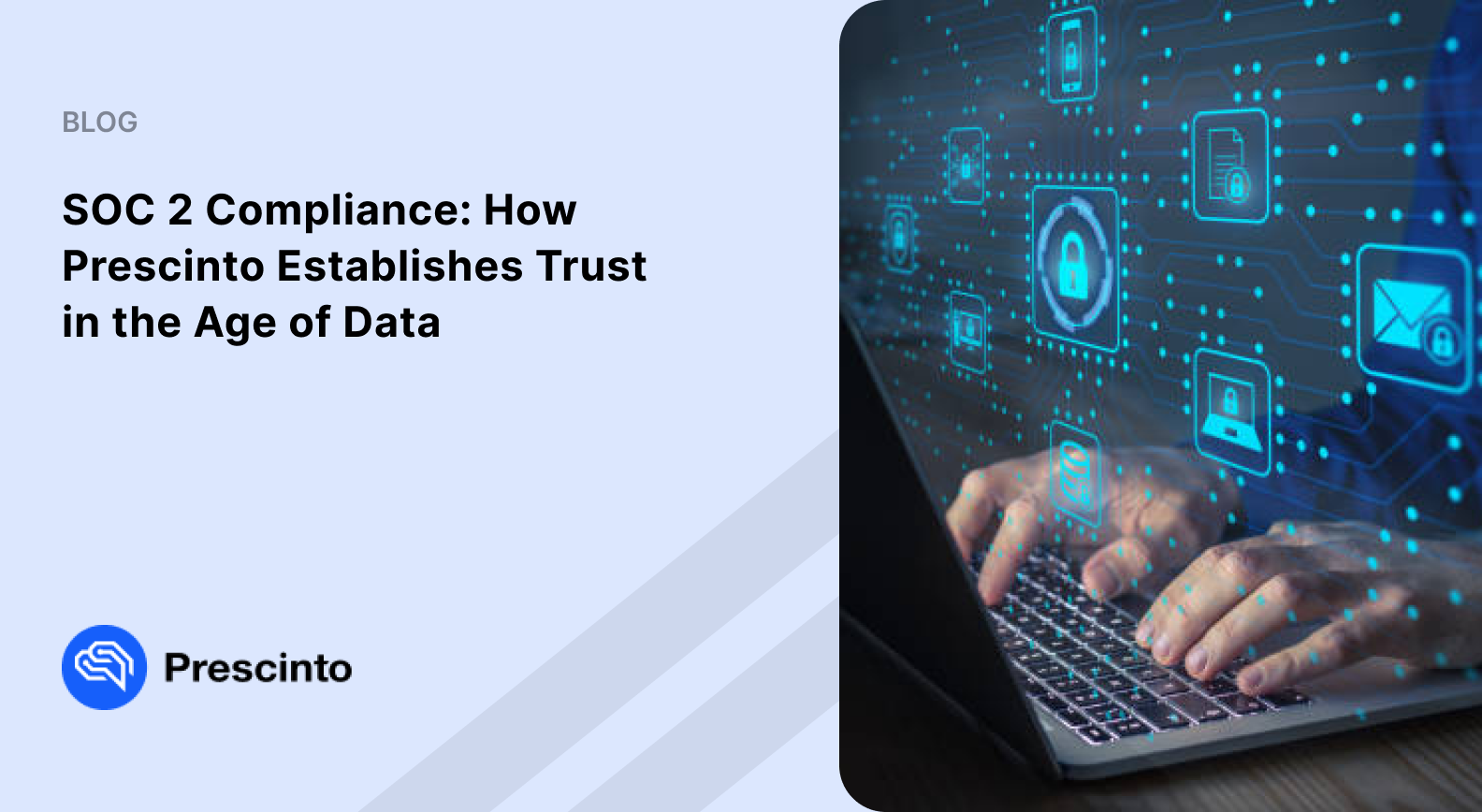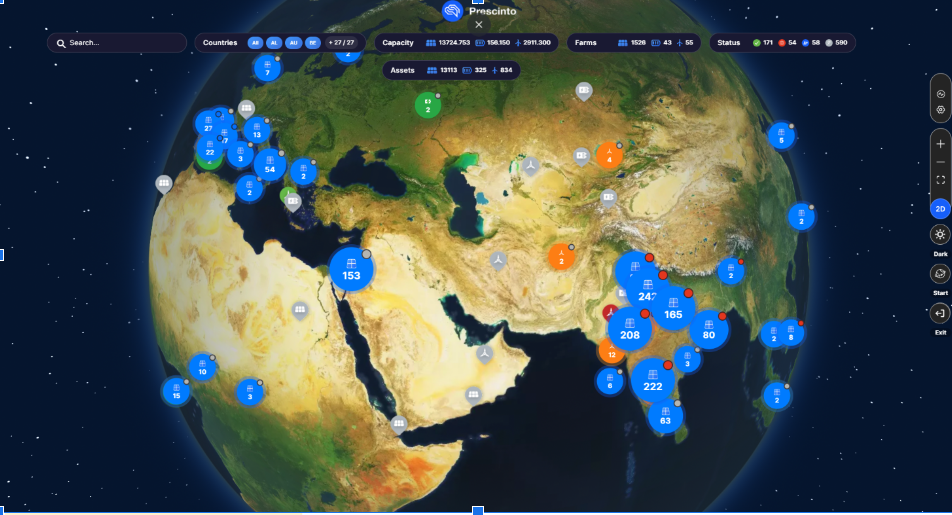Unveiling the Power of Digital Solar PV Asset Monitoring for Optimal Performance
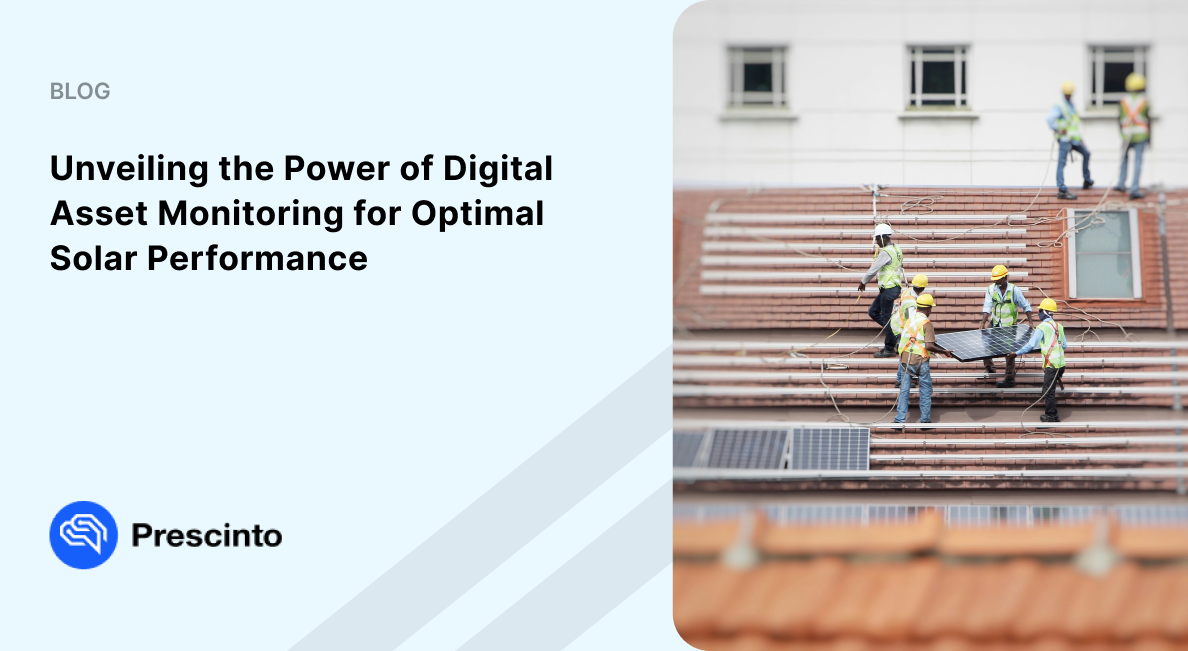
- March 10, 2024
- Prescinto
Unveiling the Power of Digital Solar PV Asset Monitoring for Optimal Performance
In the optimization of solar PV plants, solar asset performance monitoring plays a crucial role. From diligently tracking performance metrics to implementing proactive condition-based maintenance strategies, this essential practice ensures peak efficiency and renewable energy optimization. As we explore how monitoring strategies bolster reliability, reduce downtime, and fine-tune energy production, we reinforce the sustainability of solar energy as a dynamic and reliable source of clean power for the future.
What is Solar Asset Performance Monitoring?
Solar Asset Performance Monitoring refers to tracking and analyzing the performance of solar energy systems or assets in real-time. It involves the use of edge and cloud technologies to collect data from solar installations, such as solar stings, inverters, meters, transformers, combiner boxes, and other components, and analyzing that data to ensure optimal performance, detect faults or issues, and improve overall efficiency on a broader level.
Whether you’re an asset owner, asset manager, O&M service provider, or part of the broader renewable energy value chain, Solar Asset Performance Monitoring places you at the forefront of optimizing solar energy systems. This strategic approach ensures that you can effectively leverage monitoring and control technologies to collect real-time data from solar installations. By analyzing this data, you can detect faults or issues promptly, ensuring optimal performance and maximizing overall efficiency in the renewable energy sector.
When considering an optimum APM strategy for solar PV assets, the conundrum of building vs buying APM platforms may arise, requiring a careful evaluation of your specific needs and resources.
To Build or To Buy – What’s the Best for Solar APM? – Download Whitepapaer Now
Solar Asset Performance Monitoring – Need of the Hour
Solar Asset Performance Monitoring systems are crucial for optimizing renewable energy portfolio performance. It provides real-time insights into solar installation health, performance, and efficiency.
Using this, stakeholders can track key metrics, manage alarms efficiently, and ensure data accuracy, enabling proactive decision-making to maximize energy production and profitability while minimizing downtime. Some of the most important key features of performance monitoring are mentioned below.
Technology Components to Centralize Solar Plant Data
Depending upon the nature of the current solar asset installation, either Edge Technologies or cloud-based components or both are required to centralize the data. In many legacy installations or installations of large size, there is a need for edge service/ device to read the data from either devices, SCADA, or PLCs. These data packets can be read at the required granularly and processing of the data can happen either at the local device or the cloud infrastructure level. In the solar plant technology has already put vital data in the cloud then through the use of API or file transfer mechanism, the data needs to be centralized in one consistent environment,
Comprehensive System Overview
Once the data is centralized, visualization components are required to give insights into the health and performance of solar assets. For large players with a number of assets spread across geographies, monitoring all installations at a glance is a requirement. It facilitates quick identification of performance variations or issues across your renewable energy portfolio. This comprehensive overview enables proactive management and optimization of solar assets.
Dashboard Views and KPI Tracking
Dashboard views and KPI tracking are essential for solar assets to monitor real-time performance metrics and ensure optimal efficiency. These tools enable operators to track energy production, system health, and equipment performance, allowing for early detection of issues and informed decision-making. By analyzing data trends and key performance indicators, solar asset managers can schedule maintenance, identify areas for improvement, and maximize energy generation and revenue. However, most often, solar asset monitoring solutions are way too rigid to allow for any level of customization in terms of the KPIs tracking and the components available on dashboards. ‘One glove, fits all’ is not the best approach when it comes to dashboard views and KPIs. Customizable dashboards have become imperative to enable stakeholders to focus on specific metrics that drive operational excellence and performance improvement.
Efficient Alarm Management
Simplify alarm monitoring and response by leveraging an efficient alarm management system. Consolidate all alarms into a single, user-friendly interface, integrating native alarms and user-defined expressions. This unified approach to alarm management enables real-time monitoring, timely intervention, and effective tracking of issues, minimizing operational disruptions and optimizing asset performance.
However, typical monitoring platforms typically provide alarms and warnings for system issues, but these notifications may not always be sufficient. They often overlook site-specific conditions and fail to deliver accurate alerts that prioritize remedial actions effectively.
A custom alert engine, on the other hand, enables plant operators to monitor key parameters that directly impact their KPIs. This includes detecting special operating conditions and analyzing multiple device readings, tasks that are currently performed manually by SCADA operators and performance analysts. By leveraging a custom alert engine, solar asset managers can enhance their monitoring capabilities, improve operational efficiency, and maximize energy production.
Data Quality Assurance
“Data, data everywhere, but not a thought to think” is a valid statement when it comes to solar assets. The Quality of the data is paramount for decision-making in clean energy power plants. Ensuring trustworthy data is crucial for performance analytics and informed decision-making.
However, monitoring and managing data quality in large power plants pose significant challenges. Traditional methods may fall short in detecting advanced problems, potentially resulting in financial losses due to decreased productivity. This highlights the importance of advanced tools to effectively detect and diagnose data quality issues in clean energy power plants.
It is important to ensure the accuracy and reliability of your analytics through a robust data governance framework. Solar asset managers must ensure that data availability and quality is monitored to guarantee precise and dependable information for decision-making. High data quality enhances the effectiveness of operational strategies, enabling informed decision-making and performance optimization.
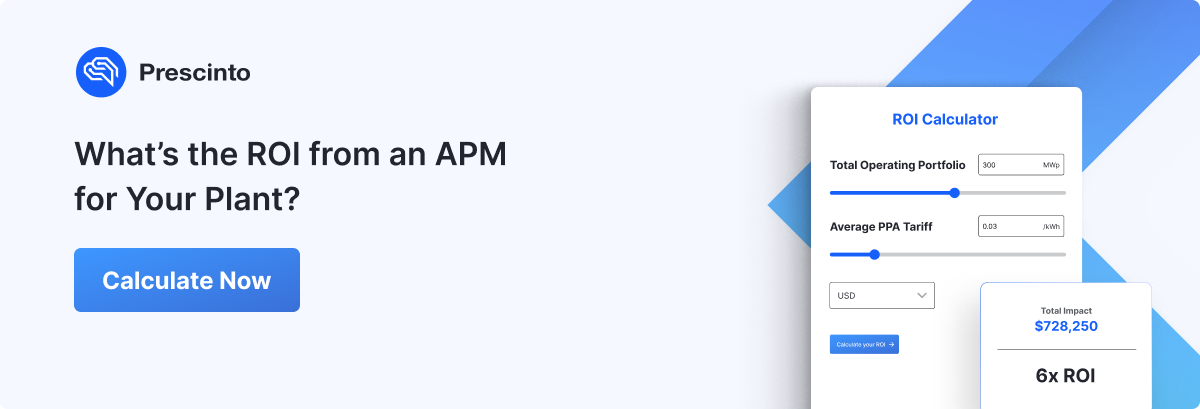 |
What Makes Prescinto’s Asset Monitoring Capabilities Futuristic and Flexible for Solar APM?
Prescinto has set a standard in the industry with robust solar asset monitoring features, crafted to deliver accurate insights into the performance and health of your renewable energy portfolio. Whether managing a small collection of solar installations or overseeing a sprawling network of solar farms, Prescinto equips solar asset managers with a suite of tools designed to empower informed decision-making and drive operational excellence.
Data Centralization Made Easy
Prescinto offers robust data import capabilities through its API, enabling direct import of data in Pandas format. The platform also offers solar asset managers a ready-made plug-in for Power BI. Any other BI tools can be easily integrated for data visualization. This flexibility eliminates the need for writing complex scripts, streamlining the data import process. Prescinto provides the flexibility to centralize data from any source. With Prescinto’s Edge Utility, data from devices, SCADA systems, or PLCs can be seamlessly brought to the cloud infrastructure using various protocols.
Prescinto’s global data center architecture ensures that data is centralized based on data security and localization norms. Additionally, Prescinto’s flexible cloud infrastructure facilitates data centralization through APIs, historians, and file transfer mechanisms, offering a comprehensive solution for managing and analyzing data efficiently.
Portfolio Overview in One Glance
The Flex Widget feature in Prescinto’s platform empowers users to tailor their dashboards by selecting specific charts and data relevant to their industry, whether in solar or wind energy. This customization extends to choosing the data format, such as heatmap charts or time series graphs, enabling users to analyze data more effectively. This flexibility enhances productivity by providing quick access to the most pertinent data, optimizing decision-making.
Prescinto’s Map View tool offers a dynamic and visual representation of renewable assets, facilitating efficient oversight and management. With interactive mapping capabilities, users can easily navigate through plants, filter assets, and access key information, ensuring informed decisions with a clear spatial context. These key features allow solar asset managers to visualize and monitor all solar assets in a single, centralized interface, enabling the swift identification of any performance variations or issues across solar plants. This view facilitates strategic decision-making and proactive management of the portfolio’s performance.
Digital Plant Assessment with Drone View and String Analysis
Prescinto’s drone view offers precise and detailed analyses of solar PV plants with unparalleled accuracy, leveraging high-resolution imagery and advanced analytics algorithms. Prescinto also offers a solution that combines drone analytics with string analysis.
In traditional drone analytics, anomalies are detected without quantifying estimated losses. However, Prescinto combines thermal imagery with string analytics to quantify estimated losses due to defects. Asset managers can empower operators to leverage this data-driven approach to plan and prioritize their remedial actions based on the impact on generation.
Custom Reports, Dashboards, and KPI Tracking Make Lives Easy
Tailor your monitoring experience to suit your unique requirements and customizable dashboards and generate custom reports to be shared with all stakeholders. Track key performance indicators (KPIs) and metrics that align with your objectives, providing you with a personalized and comprehensive view of your portfolio’s health and efficiency.
From energy production metrics to equipment health indicators, Prescinto enables you to monitor the metrics that matter most to your operations, facilitating data-driven decision-making and performance optimization.
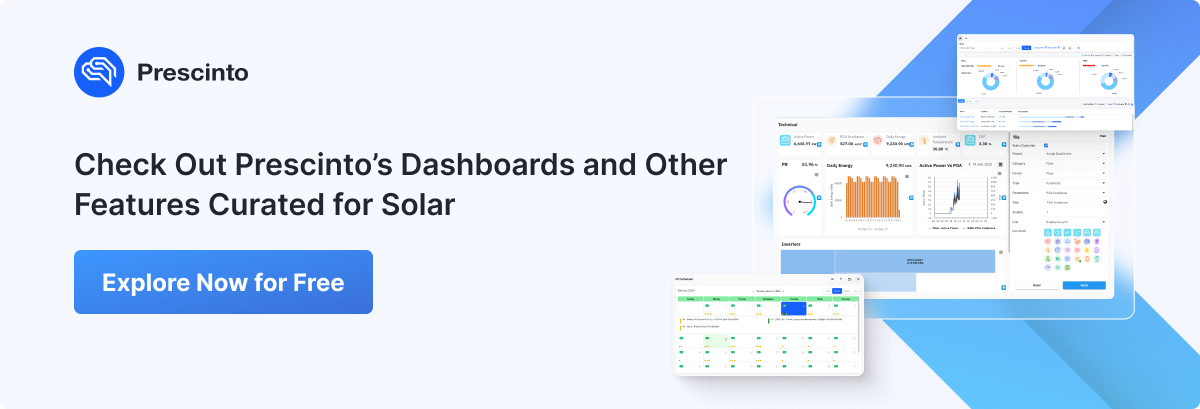 |
‘No-Nuisance’ Custom Alarms
Simplify alarm monitoring and response with a unified alarm window. By consolidating all alarms into a single, user-friendly interface, the system streamlines the monitoring, management, and tracking of alerts. Native alarms and user-defined expressions are integrated, enabling you to efficiently address potential issues and minimize downtime, thereby maximizing the reliability and availability of your renewable energy assets.
Prescinto allows for custom alarms and enhances alarm management by enabling conditional filtering for notifications, reducing false alarms. The platform’s rule-based custom alert engine accelerates the identification of underperformance, allowing users to customize rules quickly and trigger alerts for all devices in their portfolio. This feature not only eliminates manual monitoring but also detects underperformance in real time, ensuring optimal performance of solar assets.
Solving Data Complexities with Data Governance and Data Security
Prescinto’s data governance module, Baikal, actively monitors data availability and quality, ensuring that the information used for analytics is accurate, reliable, and actionable. Data governance enhances the precision of your decision-making processes, enabling you to derive meaningful insights and drive continuous improvement across your renewable energy portfolio.
Additionally, Prescinto prioritizes security with SOC 2 Type 2 compliance, following rigorous standards for hardware, software, and network security. Adhering to IEC-62443 cyber security standards, the platform incorporates built-in security measures, two-factor authentication, and location-based checks. Data segregation ensures each customer’s data is protected and accessed only as necessary for anonymized learnings and portfolio benchmarking. Prescinto’s Data Lake ensures consistent data across shared models, providing a secure and reliable single source of truth for all users.
Automated Work Order Management and Mobile App Capabilities
Take control of your asset management workflow with our tailored alerting system. Prescinto’s CMMS module offers a seamless automation process, starting from work order generation to assignment. It streamlines maintenance operations by automatically generating work orders based on specific conditions and thresholds, including custom alerts, alarms, and warnings from field devices. This automation reduces manual effort, improves compliance, and boosts productivity by allowing users to focus on more critical tasks.
The Prescinto CMMS mobile application extends these capabilities, enabling users to create, track, and update work orders on the go. The application provides a comprehensive calendar view, allows for photo uploads, and offers a simple monitoring dashboard for quick access to key performance metrics.
Bottomline
Solar PV assets require a tech partner with industry expertise to fulfill their APM needs effectively.
The success of solar assets hinges on selecting the right tech partner with industry expertise for their APM needs. This partner must offer flexibility, comprehensive data centralization, and customization options to meet the unique requirements of solar asset operators. The chosen solution should address key challenges such as skilled labor shortages and remote operational hurdles. Understanding the on-field challenges faced by solar asset operators and facilitating collaboration between O&M and asset managers is crucial.
By partnering with a knowledgeable and adaptable tech provider, solar asset owners can ensure optimal performance, and efficient operations, and ultimately, maximize their return on investment.
About Author

